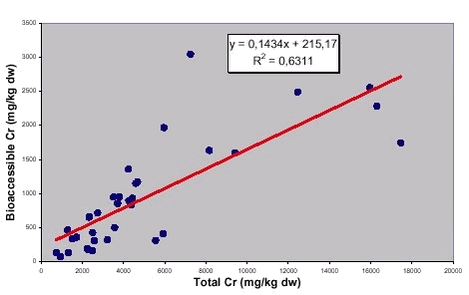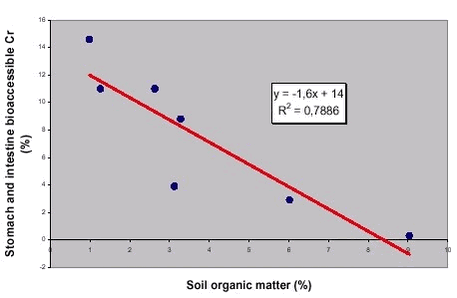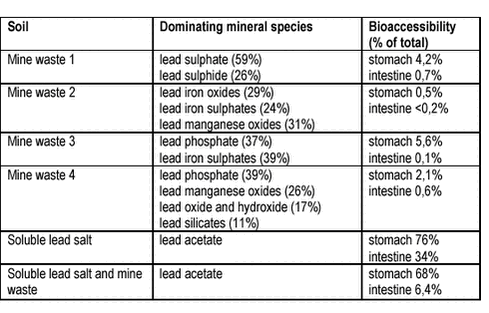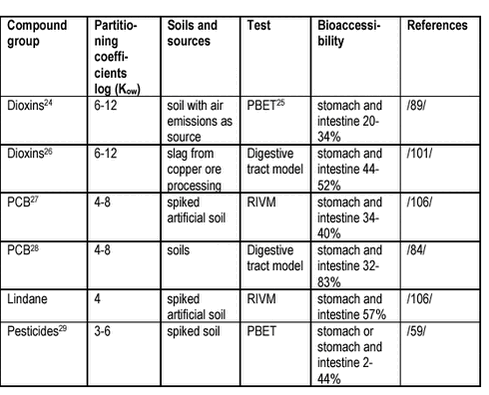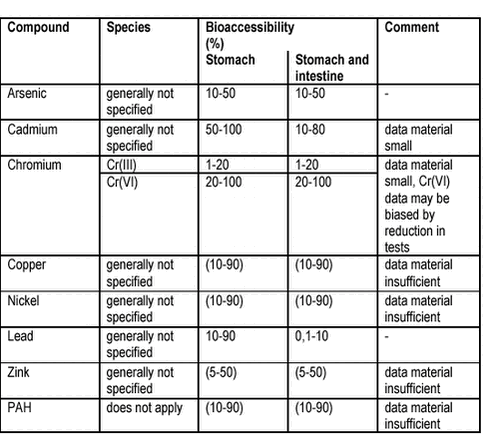Human Bioaccessibility of Heavy Metals and PAH from Soil7 Bioaccessibility data7.1 Heavy metal bioaccessibility7.2 PAH bioaccessibility 7.3 Overall contaminant bioaccessbility During the last 10 years, bioaccessibility data have been published for both the metals and PAH from soil. The data are presented in the appendix and summarised in the last part of this chapter, and specific studies are briefly described below, in particular where relationship between bioaccessibility and soil or contaminant properties can be deduced. It should be noted that in this review, the term “mine waste” is used when the source of soil contamination is all types of mining and ore processing activities. Also, data have not been discussed separately for sources and source impacted soils, e.g.: an incineration slag and a slag contaminated soil. As a comment to this, most reported bioaccessibilities of cadmium and chromium from soils are below 100%, see appendix, whereas test of slag from steel industries for stomach bioaccessibility with a method resembling the GJST method demonstrated 100% bioaccessibility of chromium (total and Cr(VI)) and cadmium /108/. In a few cases, general soil properties are measured and a sufficient number of soils tested for bioaccessibility to allow for correlation (native soil studies). Also, a few mechanistic studies have been performed using addition of soluble metal salts to different soils and measurements of the resulting speciation and bioavailability (spiking studies). Native soil studies are closer to the diversity of real contaminated soils but in such studies, bioaccessibility differences caused by different source mineralogy and speciation might overrule the effects of soil properties. Spiking studies are easier to interpret, but the simplicity and artefacts arising from this should be borne in mind during interpretation. 7.1 Heavy metal bioaccessibilityThat soil total concentrations does not necessarily indicate bioaccessible concentrations can be seen from figure 7.1 presenting data from a study with CrCl3 added to 35 different soils covering typical soils encountered at US Department of Defence contaminated sites /77/. For the same total Cr concentration of approximately 6.000 mg/kg dw, the measured bioaccessible concentrations were in the range 300-2.000 mg/kg dw. Different soil properties resulting in variations in Cr speciation were responsible for the varying bioaccessibility. A similar lack of correlation between bioaccessibility and total concentrations were observed in a study of arsenic, cadmium, chromium, lead and nickel in 22 soils /99/. In a spiking study with 36 soils, it was demonstrated that soils with high contents of iron oxyhydroxides (5 g/kg dw) and low pH reduced bioaccessibility of added arsenate, As(V), whereas the remaining soil properties did not impact the bioaccessibility (e.g.: CEC) or was interpreted to have an indirect effect of local pH variations (carbonate) /42/. In a study of arsenic bioaccessibility with the PBET method covering 110 US soil samples, bioaccessibilities in the range 10-60% were found with the arsenic mineralogy and the soil particle size as the major determinands of bioaccessibility (/109/, as referred in /12/). Figure 7.1
Preliminary indication has been presented of a higher bioaccessibility of Cr(III) and Cr(VI) added to soils as soluble salts after cold storage (2-3 ° C) as compared to storage at higher temperatures (21-25 ° C) /110/. Figure 7.2
With data on 7 soil samples from one site contaminated with construction waste /95/, no general correlation could be observed between bioaccessible chromium or lead (stomach and stomach/intestine) and soil properties such as cation exchange capacity (CEC), soil organic matter (SOM), soil pH or even with total soil concentrations of the same metals. Only stomach/intestine bioaccessible chromium did exhibit a linear correlation with soil organic matter (SOM), figure 7.2. The correlation is not strong but can result from SOM mediated reduction of soluble, anionic Cr(VI) as chromate to less soluble, cationic Cr(III). For this particular study, it should be noted that the variability of results for the same soil was larger than generally accepted, for several samples in the range of 100%. The effect of SOM on Cr bioaccessibility and the underlying mechanism was supported by a detailed study on the effects of aging on chromium bioaccessibility and speciation /43/, see section 4.2. It was demonstrated that Cr(III) was less bioaccessible from soils with high (> 5,5) pH and high SOM, whereas Cr(VI) was less bioaccessible from acidic soils with high contents of iron oxyhydroxides. Cr(VI) was transformed to the less bioaccessible Cr(III) in all soils, but most with high SOM. Further studies demonstrated that Cr(III) found as Cr(OH)3, mostly in alkaline and calcareous soils, is far less bioaccessible than Cr(III) found as Cr+++ bound to the clay cation exchange sites /77/. Furthermore, these studies suggest that Cr(III) bound to SOM has limited bioaccessibility. Conversely Cr(III) can be adsorbed to clay minerals by ion exchange yielding high concentrations, but clay mineral bound Cr(III) is bioaccessible due to the ready desorption by acid. Table 7.1 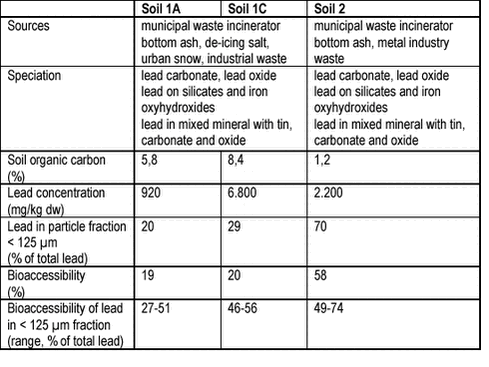 Click on the picture to see the html-version of: ‘‘7.1‘‘ For lead added to 11 different soils as soluble lead salt, stomach bioaccessi-bility decreased with increasing cation exchange capacity /111/ as would be expected for the cation lead with high affinity for cation exchange. Soil particle size have been demonstrated to impact lead bioaccessibility (the GJST test, /52/), but the study did not demonstrate whether this was due to different speciation of lead in small particles or to an impact by the soil particle size directly. Bioaccessibility of lead from small particles (< 63 µm) up to 5 times higher than from large particles (1-2 mm) was reported, see figure 6.1. The effect of soil organic matter and soil particle size on lead bioaccessibility can be demonstrated from this study, table 7.1. The lead bioaccessibility with the simple stomach simulating test GJST was 2½ times higher for the soil with low SOM (measured as organic carbon) and a high content of lead in small particles, /52/. High SOM can prevent dissolution of soil bound lead by the gastric acid, whereas small particle have a larger surface and consequently exhibits faster dissolution. No other soil (inorganic carbon, texture), site (source type) or speciation (mineral distribution of lead) properties could explain the large difference in bioaccessibility. Conversely, higher bioaccessibility was reported with the PBET test for soils with higher SOM /82/. The suggested explanation here was that the presence of soil organic matter during weathering of mine waste minerals causes binding of the released lead by cation exchange followed by release in the acidic stomach simulation, whereas the lead minerals formed in the absence of SOM are less acid soluble.‘ Table 7.2
The lead iron oxide dominated soil exhibited lower bioaccessibility than the soils dominated by lead sulphate, sulphide and oxide. Furthermore, even for the soluble lead acetate, the presence of mine waste decreased bioaccessibility in the stomach simulating test and even more including the small intestine simulating test. Finally, table 7.2 clearly demonstrates that lead was precipitated and thus exhibited reduced bioavailability upon transit from the stomach to the small intestine. Also, very soluble lead minerals as lead acetate, which is frequently used for in vivo bioavailability studies, dissolves much faster than the less soluble lead sulphate and than soil lead /82/, see figure 6.5. Furthermore, the dissolution of soil lead minerals depends not alone upon the mineral present, but also upon the presence of “coatings” with other minerals /93/. Such coatings and also more soluble lead minerals (carbonates and iron oxyhydroxides) are more likely to be formed in soils and wastes with lower pH /82/. Lead sulphate constituted 59% of the lead in a soil tested for dissolution simulating stomach conditions (figure 6.5), but the dissolution rate was much slower for the soil than for the pure mineral and again, the final dissolved concentration was considerably lower. In a study of As, Cd, Cr, Ni and Pb bioaccessibility with the DIN method /99/, no correlation could be found to soil organic matter. A study including 7 German soils demonstrated correspondence between the bioaccessibilities of Cd, Cr, Ni and Pb and their distribution in fractions obtained by sequential extraction, see chapter 6 /99/. These data further support that the soil mineralogy interacts with bioaccessibility but a direct interpretation is not straight forward. 7.2 PAH bioaccessibilityThe number of studies of PAH bioaccessibility is limited and includes only two methods (DIN and Digestive tract model) performed at one institution, see appendix. Additionally, a modification of the PBET test including the intestinal step only has been applied for PAH from soil /90/ but data were not available at the time of that publication and subsequent publication of data has not been found. A study of PAH bioaccessibility from 4 coal mine waste and waste contaminated soils did not exhibit the expected lower bioaccessibility neither with higher soil organic matter content, nor generally with increasing PAH partitioning coefficient /99/. Still, one soil (Lothringen 2, see chapter 8) did exhibit the decreasing bioaccessibility with increasing size, ring number and partitioning coefficient that would be expected if reduced bioaccessibility was caused by absorption in soil organic matter only. Similarly, a study of PAH bioaccessibility with 5 waste contaminated soils from one German site showed overall bioaccessibility of total (11) PAH of 11-15%. The mean bioaccessibilities for the 11 individual PAH were all in the same range, except for phenanthrene that exhibited a mean bioaccessibility of just above 20% /100/. A validation study of the RIVM test for bioaccessibility of benzo(a)pyrene concluded that considerable variation (14-50%) in bioaccessibility was observed for additions of different amounts of the contaminant (higher contaminant concentration) to the same soil /11/. A larger bioaccessibility was seen from spiked sandy and silty soils (texture effect), as compared to loamy soils. A few bioaccessibility studies of other organic contaminants from soil turned up in the literature survey (not specifically sought for) and their data are quoted below for perspective, table 7.3. For the polychlorinated dibenzodioxins and –furans, no correlation between bioaccessibility from soil contaminated via industrial emissions to the air and congener partitioning coefficients was observed /89/, but the range of bioaccessibilities were the same as the ranges reported for bioavailabilities to rodents. Still, for dioxins from copper ore processing, a correlation between bioaccessibility and congener partitioning coefficient was observed /101/. Table 7.3
7.3 Overall contaminant bioaccessbilitySummaries of the reported bioaccessibilities of the 7 heavy metals and the 7 PAH are given in table 7.4, and all data can be found in appendix. It should be noted that the typical intervals in table 7.4 are overall range estimates that should not be used for setting general bioaccessibility values. Data are compared across source types, species and methods and this allows for identifying major differences only. Also, a high variability of measured bioaccessibilities for same contaminant and same type of source, soil and test method precludes generic use of the reported values, see appendix. As an overall conclusion it can be stated that all studied metals and PAH might exhibit bioaccessibility well below 100% in a particular contaminated soil, but cadmium, lead and chromium (Cr(III)) are most likely to do so. No generic correlation between contaminant bioaccessibility and compound, soil or source properties can currently be deduced from the data. Properties of importance for one contaminant are summarised in above sections but in most cases, reported data can be found contradicting an emerging generic statement. Access to an increased amount of bioaccessibility data for different sources and soils but with one method will enable more reliable generic statements on the relation between sources, soil characteristics and bioaccessibility. Likewise, more bioaccessibility data for different compounds and species but with one method will enable a better understanding of the contaminant properties determining bioaccessibility. Table 7.4
_____________________________________________________________ |
